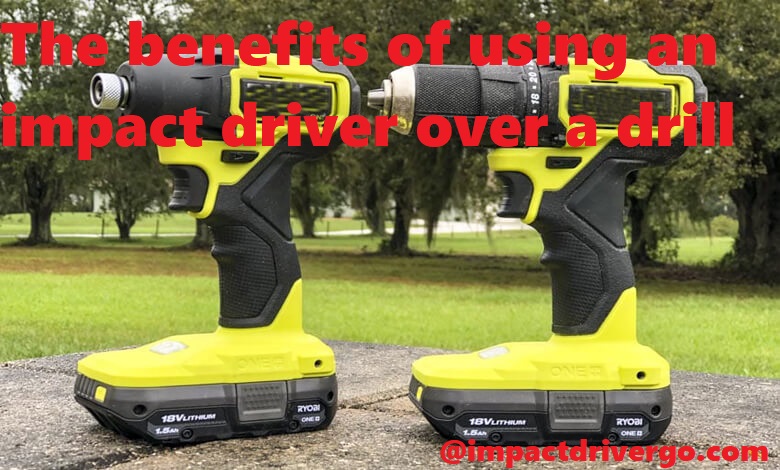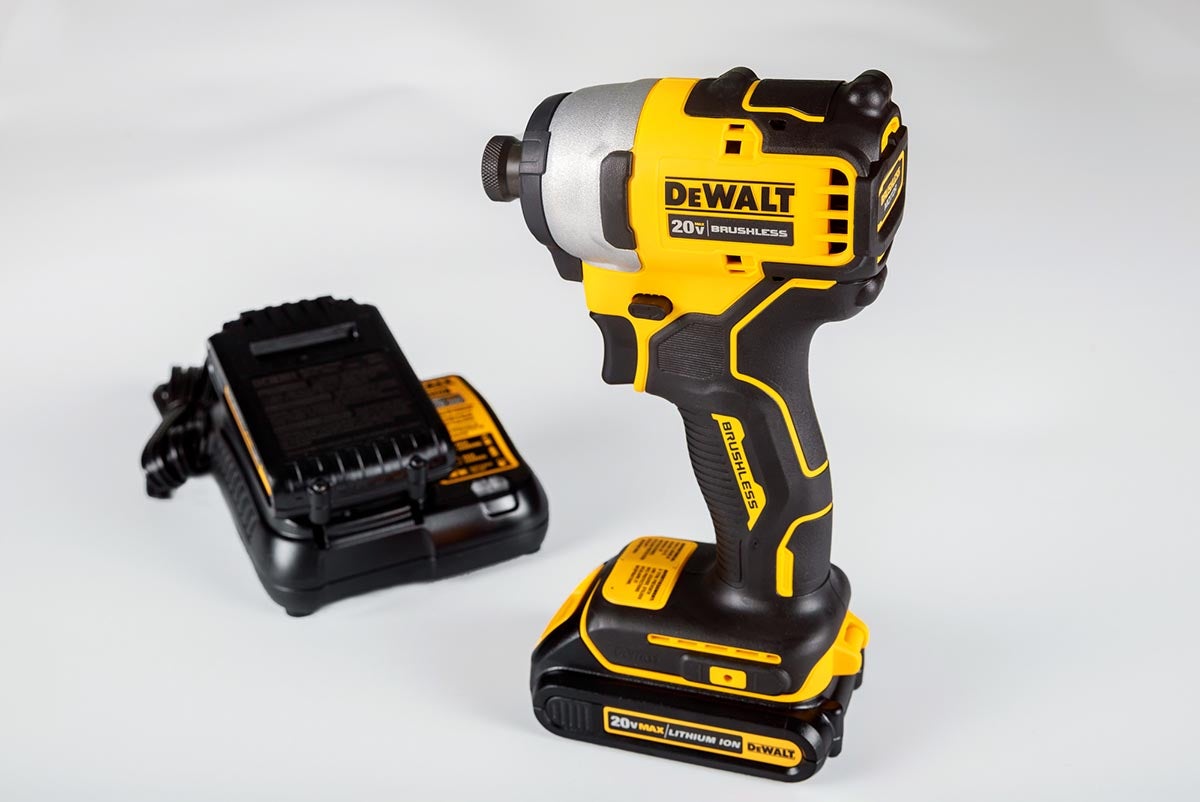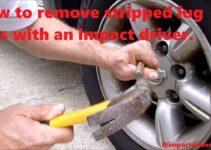Are you tired of using your conventional drill without having any success in completing that tough task? An impact driver is just the tool you need to get the job done.
This guide will explain why you should use an impact driver over a drill, and provide helpful insights into how to use an impact driver correctly. You won’t have to worry about tightening screws ever again – let the power of an impact driver help!
Introduction – Impact drivers offer a number of advantages over traditional drills. In comparison to the standard drill, an impact driver is capable of exerting far more torque, making it the right choice for driving large fasteners and bolts. It’s also smaller, lighter and easier to manipulate in tight spots than a standard drill, allowing you to access places where a traditional drill simply won’t fit or is difficult to use. Add in the fact that it can drive screws at speeds as much as six times faster than your average drill and it’s easy to see why this tool is becoming increasingly popular for home improvement enthusiasts and professionals alike.
This guide will explain what makes an impact driver so effective, provide tips on how and when to use one, and discuss the safety considerations associated with operating an impact driver.
Explanation of what an impact driver is
Impact drivers use a hammering motion to help drive screws and other fasteners into a variety of materials. Unlike regular drills, impact drivers utilize RPMs (revolutions per minute) and IPMs (impacts per minute) to create torque in order to help ensure the fastener is driven into the material. An impact driver has an adjustable sleeve at the base of the handle that allows for different levels of torque to be applied. This provides a more efficient way to drill holes and drive screws than with just a drill alone.
Simply put, an impact driver is designed to help break through material resistance that would be too tough for a regular drill bit. The dual action of both rotational force and hammering motion allows it to range in speed and lengthier bolts can be driven into even the toughest materials with relative ease–all while delivering greater control over depth and accuracy.
Impact drivers also have smaller heads than standard drills, making them perfect for tight work areas where larger drill bits would not fit. This makes it easy to work with confined spaces like behind appliances or in electrical boxes without sacrificing power or accuracy.
Brief comparison of an impact driver and a drill
The traditional drill is capable of driving screws and making holes in materials, however, an impact driver can drive screws much faster while still being lightweight and easier to use. Both tools can drill into various materials like wood, plastic and metal and both should be used in forward rotation only.
When compared, an impact driver offers several advantages over a traditional drill, such as higher torque for driving large screws into dense materials and a one-handed operation that reduces fatigue when working overhead or in a tight space. An impact driver also has a smaller head size than an electric drill which allows it to reach tighter spaces more easily and makes it better suited for more demanding screwdriving projects. It does this by using high speed rotation that creates high torque bursts when needed for larger diameter fasteners or heavy-duty driving applications. Finally due to its short length, an impact driver is far less likely to cause damage or marking on delicate surfaces with regular use.
Benefits of using an impact driver
Impact drivers are versatile tools that make a wide range of jobs easier and faster. There are many benefits to using an impact driver instead of a drill, which explains why they have become so popular with professionals and DIYers alike. Here are just a few of the benefits associated with using an impact driver:
- Greater Torque: Impact drivers generate up to two or three times more torque than standard drills, making it easy to drive screws into heavy materials without damaging them. As an added bonus, the rotational force eliminates the need for additional muscle power when driving long screws into hard materials like wood or metal.
- Faster Drilling Speeds: The increased torque of an impact driver doesn’t just make drilling easier – it also speeds up the process significantly. This can be a huge time saver in applications where you need to drive several screws quickly and efficiently.
- Lightweight and Compact: Impact drivers were designed with portability in mind, making them much lighter and more compact than traditional drills. The convenient size makes them ideal for tight areas where larger tools cannot fit and for working at height or in confined spaces such as ceilings and attics.
- Increased Battery Life: Impact drivers often feature longer battery life than standard drills due to their efficient design which minimizes drain on power reserves during periods of extended use. This effectively reduces downtime between charging intervals, allowing users to get the job done more quickly with fewer interruptions from dead batteries or power cords that have limited reach in certain situations.
Greater torque
An impact driver offers greater torque than a conventional drill. This makes it better suited to applications where you need to drive a fastener into hard materials such as wood and metals. In general, an impact driver has up to 4 times the torque of a drill. This increased power means that it can usually complete the same job in less time, saving you effort and time.
Additionally, the higher level of torque also reduces the chances of damaging materials because it won’t require as much pressure on your workpiece. Impact drivers are popular with carpenters, plumbers and metal workers who often need to drive screws into hard surfaces such as concrete or steel pipes.
If you are going to be working with large screws or bolts in these materials, an impact driver is highly recommended for producing good results in significantly less time and effort.
Explanation of torque and its importance
Torque is one of the most important components when it comes to any drill. It is the measure of rotational force and can make a significant difference in your performance. Torque helps determine how much power a tool has and how capable it is at drilling through tough materials or performing difficult tasks.
An impact driver produces significantly more torque than a regular drill, allowing for greater control and higher efficiency when completing tasks that require heavy-duty drilling. With an impact driver, users will be able to easily drive screws into hardwood with minimal torque going to waste due to slipping or stalling drills like traditional drills can sometimes experience. Additionally, because impact drivers produce such high levels of torque, they can quickly tighten larger and longer fasteners into even harder substrates with relative ease compared to regular drills.
Impact drivers are also light-weight and balance comfortably in the hand for easy maneuverability during extended applications; in comparison, most drills cannot remain comfortable for users after prolonged periods of time due to their heavier weight design.
Comparison of torque between a drill and an impact driver
The differences between a drill and an impact driver are largely related to torque. Torque is defined as a measure of the force used to turn an object or the power behind a tool’s rotation. In terms of basic use, torque determines how much torque is required to drive fasteners or screws into various material types.
A drill generally has an adjustable torque level, meaning you can adapt the power it uses based on the job at hand. This is great for lighter tasks that don’t require a huge amount of force but won’t get you far if you need to drive large screws into dense material. On the other hand, an impact driver operates with a predetermined amount of torque. That amount is usually much higher than that of a drill; depending on the model, it can reach up to 2,000 inch-pounds (in-lbs). This makes it ideal for driving large screws and fasteners into tough surfaces like wood or concrete and offers far more precision than what you could ever get from a drill alone.
Impact driver features
Impact drivers are engineered with several unique features that make their use far more efficient than drills. A few of the key features and benefits include:
-Higher torque output: The highest torque ratings occur during fastener tightness when the clutch slips, making impact drivers ideal for a variety of fastening applications.
-Smaller size: Impact drivers are compact and generally lightweight, making them easier to maneuver in tight areas. This makes them well suited for use in overhead tasks or when working in limited spaces.
-Greater accuracy: Impact drivers provide more precise control over this action, allowing you to drive screws precisely where you need them without having to worry about over-tightening or under-tightening fasteners.
-Reversing capability: Many impact driver models offer a reversible design that allows you to quickly switch between forward and reverse operation so that you can remove any stuck screws quickly and easily.
Types of impact drivers
Impact drivers are engineered for high torque fastening applications and provide superior performance for tightening screws and other fasteners, such as nuts and bolts. Impact drivers come in a variety of sizes, power ratings, and styles. Understanding the features of each type will help you choose the right impact driver for your projects.
Cordless impactdriver: This type of impact driver is battery-powered and can offer greater freedom of movement while working on projects since there is no need to be near a power outlet or extension cord. They also tend to offer longer runtimes than corded impactdrivers, making them ideal for all-day use.
Pneumatic impactdriver: These are powered by compressed air and require an air compressor in order to operate properly. These are typically used where extended periods of use would be required, such as large scale construction jobs, due to their consistent availability of air pressure and high torque capabilities.
Cordedimpactdriver: Corded models are plugged into a nearby electrical outlet. The advantage these have over cordless models is that they can quickly reach full speed range without waiting for the battery to charge. The tradeoff is that there needs to be access to an electrical source nearby in order to use it properly – this not only limits portability but may also create potential hazards depending on the job site environment.
Corded vs cordless impact drivers
Corded and cordless impact drivers are both power tools that use a rotating shaft and hammering action to drive in, or out, fasteners. However, each type of impact driver has its own specific advantages, depending on the needs of the user.
Corded impact drivers have been around for decades and are still preferred by many professionals because of their greater power. Corded impact drivers usually run off AC current and can be more powerful than cordless models due to the steady flow of electricity from the source. The majority of corded drivers also feature an adjustable torque setting which is great for sensitive applications such as when driving screws into concrete or other hard materials.
On the other hand, cordless impact drivers are becoming increasingly popular among DIY enthusiasts as they’re more portable than their corded counterparts. Cordless models usually run off rechargeable batteries so you don’t need to worry about cords getting in the way when working in tight spaces like behind walls or below floors. They’re also suitable for occasional use as you can charge up anytime with little preparation required before starting work. Furthermore, cordless models weigh significantly less than those with cords attached which makes them much easier to transport while working away from home or on a job site.
Ultimately, choosing between a corded or a cordless impact driver depends on your needs as well as which features are important to you such as weight, portability and power level needed to complete your task efficiently.
Brushless vs brushed motors
Drills and impact drivers are common tools used in home improvement and construction projects, but they come in various forms with different features. In particular, two types of motors are available when shopping for a cordless drill or impact driver: brushless or brushed.
There are several differences between brushless and brushed motors that should be considered before deciding which type of tool to buy. Brushless motors require less maintenance and last longer due to the lack of physical contact components that can create friction, heat and wear over time. Brushless motors are also more efficient as they can reach greater speeds than brushed models, making them suitable for high-torque applications such as driving long screws or lag bolts.
On the other hand, brushed motors typically have less expensive price tags than brushless alternatives due to their use of traditional materials. These motor types do not suffer from self-discharge issues like those encountered by a brushless motor for extended storage periods. They also have simpler control systems and fewer components which makes them easier to repair in comparison to the more complex brushless type.
Overall, if you’re looking for maximum power output with minimal fuss then a brushless motor is your best option while if you want an affordable tool that still has reliable performance then a brushed model may be your answer.
Conclusion
In conclusion, impact drivers are the best choice for construction and home improvement projects that require driving large numbers and varieties of screws. While more expensive than traditional drills, impact drivers provide superior performance with less effort from the user. Generally speaking, they possess higher torque and longer run times when compared to their drill counterparts, making them ideal for a variety of specialized projects.
For highly reliable results in driving screws even in concrete and other tough materials, a quality impact driver is an investment worth considering.
FAQs
Is better to own a drill or impact driver?
It depends on the task at hand. Both tools have their own unique uses.
When should I use impact driver over drill?
An impact driver is best for driving long screws or bolts into tough materials like wood or metal.
Can you just use an impact driver to drill?
No, an impact driver is not designed for drilling. It lacks the necessary torque and speed control.
What to look for when buying a drill and impact driver?
Consider the power, speed, chuck size, and battery life when buying a drill or impact driver.
Can I use impact driver to drill concrete?
No, an impact driver is not suitable for drilling into concrete. You need a hammer drill for that.
Can an impact driver hold a drill bit?
No, an impact driver is not designed to hold drill bits. It uses hex-shank bits for driving screws and bolts.
Can I use an impact driver for self drilling screws?
Yes, an impact driver is perfect for driving self-drilling screws into wood or metal.
Do I need an impact driver if I have a hammer drill?
It depends on the task at hand. An impact driver is better for driving screws, while a hammer drill is better for drilling into tough materials like concrete.
Is a drill or impact driver more versatile?
A drill is more versatile as it can be used for drilling, driving screws, and other tasks. However, an impact driver is better for driving long screws or bolts into tough materials.
Which is better impact or hammer drill?
It depends on the task at hand. An impact driver is better for driving screws, while a hammer drill is better for drilling into tough materials like concrete.
See Also-
- Best impact driver for automotive use
- Best impact driver for mechanics
- Best impact driver
- Best impact driver for lug nuts
- Best makita impact driver


